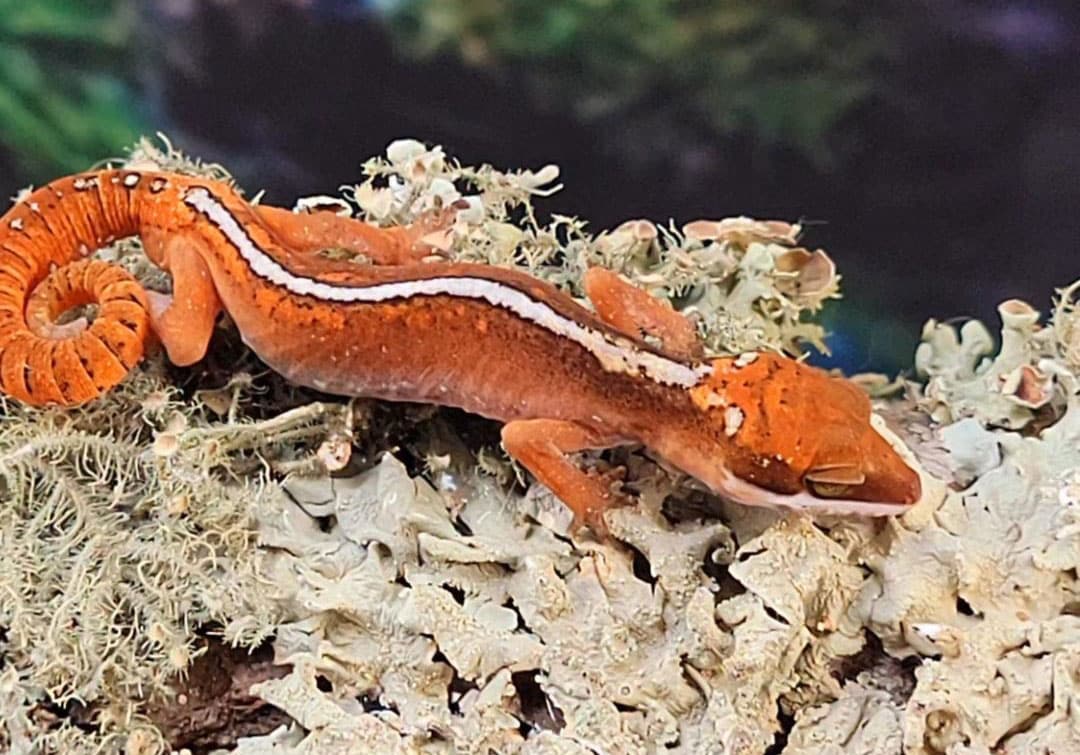The Malaysian cat gecko (Aeluroscalabotes felinus) is a fascinating lesser known gecko species in the reptile community belonging to the sub-family Aeluroscalabotinae.
The Malaysian cat gecko (Aeluroscalabotes felinus) is a fascinating lesser known gecko species in the reptile community belonging to the sub-family Aeluroscalabotinae. They are native to Southeast Asia and are particularly found in Malaysia, Singapore, Thailand and Cambodia. Additionally, a distinct sub-species exclusive to Indonesia has been identified, specifically found in Sanana of the Sula Islands, known as A.f. multituberculatus.
The cat gecko was first described by Albert Gunther (1864) a German-born British zoologist known for his significant contributions to the field of herpetology. They are the only species within the genus Aeluroscalabotes. They belong to the family Eublepharidae, which includes other gecko species commonly known as “eyelid geckos” due to their movable eyelids.
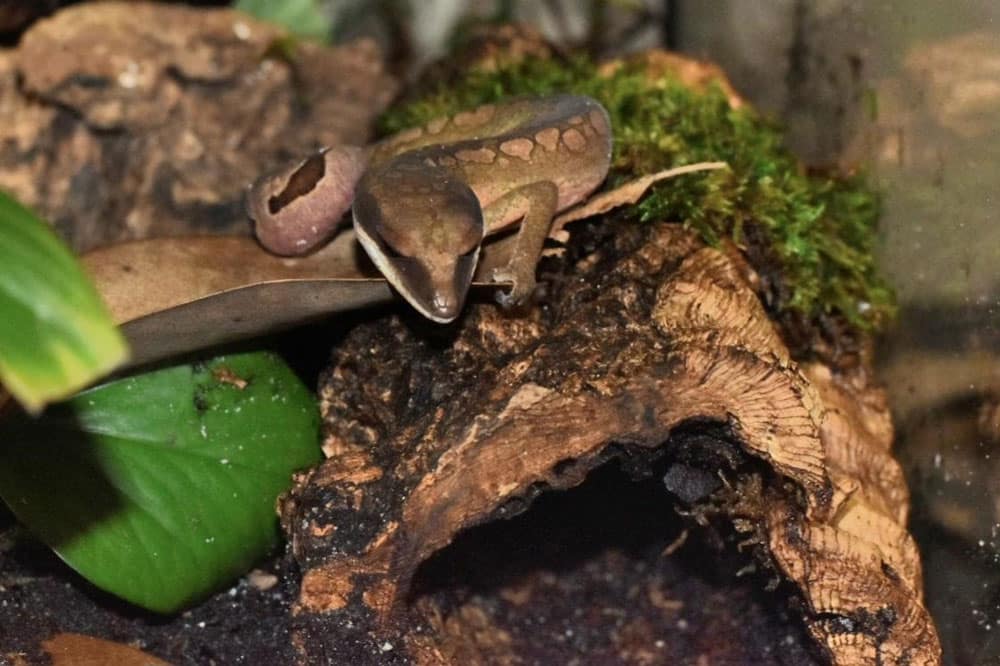
Cat gecko atop a log in a naturalistic terrarium. Photo by Monique Karl
Three recognized subspecies of cat geckos are known. The most popular one is A. felinus of the Cameron Highlands region in the state of Pahang, Malaysia. The area is known for its cool climate and montane rainforest. The majority of wild-caught cat geckos that are imported into the United States come from the Cameron Highlands region.
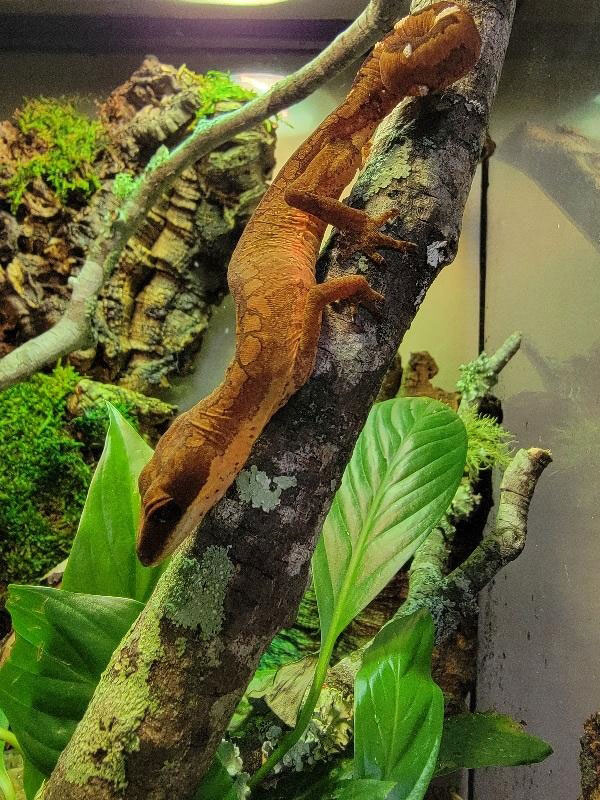
Ensure that the enclosure has plenty of climbing branches for your cat gecko. Photo by Monique Karl
Another known locale, A. felinus silver-eyed are from Johor in the warmer southern part of Peninsular Malaysia. This locale is very rare and has been protected by the local government. There may be a few reptile breeders in Europe who are breeding them, but there are currently no available imports to the United States. The last locale or subspecies is A. dorsalis, the green-eyed cat gecko from the island of Borneo in Southeast Asia. The characteristics of the Borneo cat geckos are very different than the A. felinus making them more of a subspecies and should not be bred together. Breeding different locales together can result in hybrids that may not accurately represent any particular locale’s characteristics. This could be problematic for breeders or reptile keepers interested in maintaining pure bred lines or preserving the unique traits of specific locales.
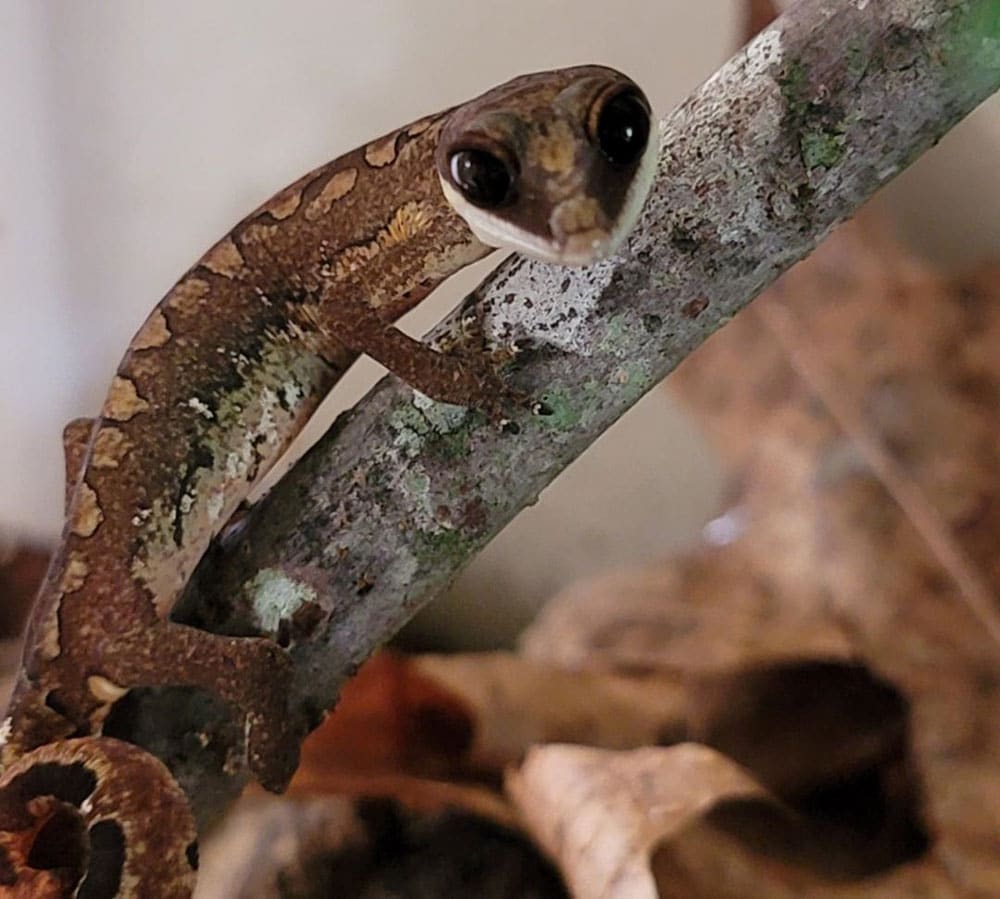
Juvenile cat gecko. Photo by Monique Karl
Physical Characteristics and Behavior
Cat geckos likely received their common name due to their somewhat feline appearance and behavior. They have a slender body and a long prehensile tail that helps them hold onto branches. They wrap their tails around their bodies while they sleep just like cats do. Females can reach 8 inches in length, while males are usually smaller around 4 to 5 inches in length. Aeluroscalabotes felinus are more of a brown, orange and rust color with a wide range of patterning. Their color helps them camouflage well under bark and leaf litter.

A. felinus. Cat geckos primarily feed on insects. Photo by Monique Karl
The differences with A. dorsalis are that they are a tad smaller than A. felinus and have greenish eyes and more of a dark maroon base color. Some will have a white stripe and some patterning going down their vertebral line. Because of their nocturnal nature, they have relatively large eyes to enhance their vision during low light conditions.They have blueish tongues and their heads, along with their bodies, are elongated and angular in shape. Other cat-like features are their retractable claws that help them grab onto branches and bark. They also have a slow cat-like walk and will hang out in the same spot for hours while hunting for prey. They are semi-arboreal as they will sleep under leaf litter and hide in small crevices during the day and climb high tree branches and various plants at night. They are elusive creatures, requiring a sense of security to flourish. When threatened they will raise up their tail and open their mouth. Their average life span is reported to be around 10 years old.
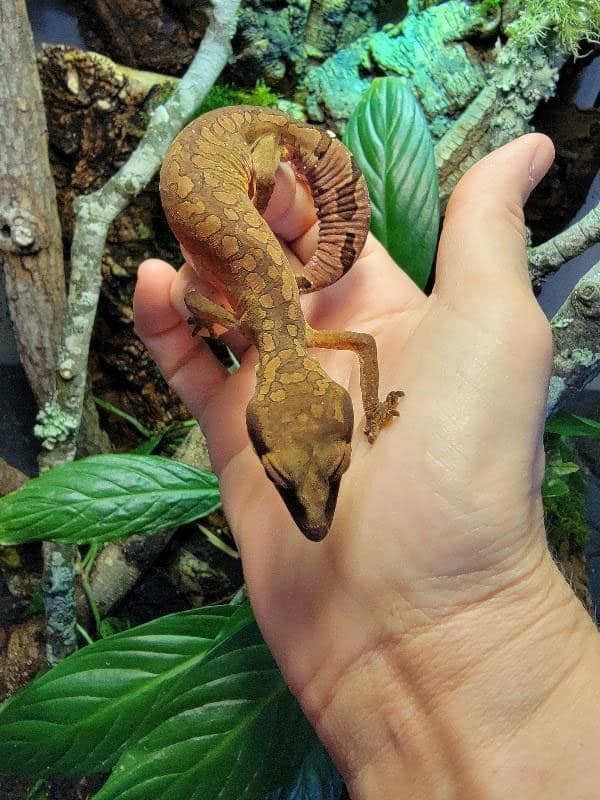
Malaysian cat gecko adult. Photo by Monique Karl
What do Malaysian Cat Geckos Eat?
Cat geckos primarily feed on insects, favoring small crickets, roaches, snails and isopods. However, they have a sensitivity to minerals, so calcium supplementation should be limited. Isopods are a valuable source of calcium, so dusting other feeders with calcium should occur only once every three weeks. Gravid females can receive calcium dusted food every two weeks. We’ve observed that crickets and isopods are their preferred insects. We feed them two to three crickets a few times a week. Having too many feeders in at one time can cause stress. When maintaining them in captivity, it’s advisable to use only R/O or distilled water for misting, as tap water contains excessive minerals that can lead to kidney stone development. These stones, similar in appearance to their urates can pose health risks if mineral intake is excessive.
Terrarium
We highly recommended you create a naturalistic terrarium for cat geckos, complete with substrate, climbing branches, real plants as well as fake plants and plenty of hiding spots and a small water dish. Due to their small and slender build, cat geckos utilize plants with large leaves and leaf litter on the substrate for security. Suitable plants such as ficus and pothos can be incorporated into their enclosures, while cork bark provides a great climbing surface and hiding spot. An enclosure around 18” x 18” x 24” or larger is ideal for a single cat gecko. Like other gecko species, males should never be housed together.
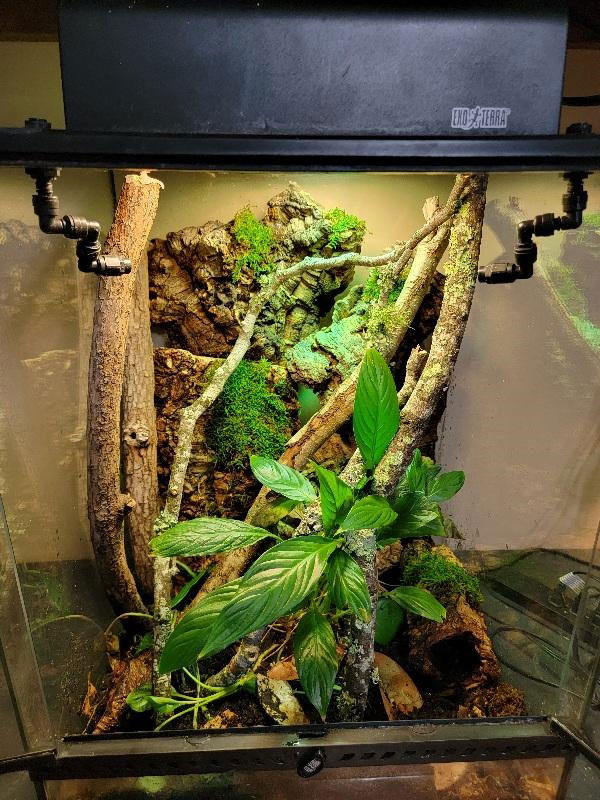
An 18″x18″x 24″ terrarium is ideal for a Malaysian cat gecko.
Cat geckos are typically found in humid rainforest environments and prefer cooler temperatures with high humidity. Maintaining humidity levels between 65-85% in their enclosure is crucial. Heavy misting at night entices them to come out and lick water droplets off the plants.
Daytime temperatures ranging from 72 to 78 degrees Fahrenheit (22 to 25 degrees Celsius) are suitable, with a nighttime drop between 66 to 72 degrees Fahrenheit (19 to 22 degrees Celsius). Despite being entirely nocturnal, providing them with a proper day-night cycle, including UVB, is beneficial for their well-being and plant growth. (The cat gecko is a Ferguson Zone 1 reptile. It is a nocturnal/crepuscular shade dweller. Choose a UVB lamp with a Zone range UVI of 0-0.7 with a maximum UVI of 0.6 to 1.4 at the basking zone. For more information on UVB and your reptiles, visit https://t.ly/zjUfZ.) A light cycle lasting 8 to 10 hours per day mimics their natural environment, ensuring optimal conditions for both geckos and plants.
Captive Breeding
First and foremost, it’s crucial to ensure you have a male and a female pair for breeding. Mature males can be identified by the presence of a hemipenial bulge and typically weigh around 15 grams. Females reach breeding maturity when they are approximately two years old and weigh around 27 grams. Breeding pairs should be housed in an 18” x 18” x 24” or similar size enclosure. This should be large enough to accommodate both geckos comfortably, with hiding spots, climbing branches, plants and substrate.
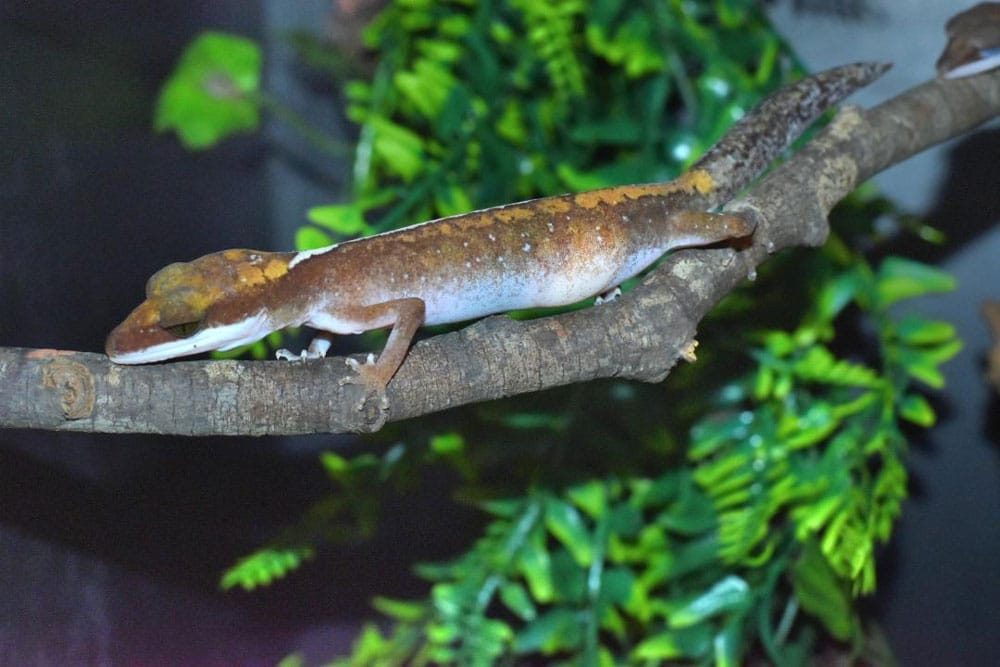
A gravid female cat gecko. Photo by Monique Karl
We house our breeding pairs together for nine months starting in late January and separating the males in the beginning of September. When ready to breed males may initiate courtship behavior. If the female is receptive, mating will occur, often with the male wrapping its tail around the female during copulation. You may occasionally notice when the females are gravid because the eggs are sometimes visible through their bodies. Our females lay two eggs every 60 days or so. They will lay their eggs in hidden locations usually buried in the substrate under their hide. Eggs will usually appear dark from the soil covering them. We’ve had babies hatch in the enclosure from a female that hasn’t been bred in almost a year, indicating that females can retain sperm.
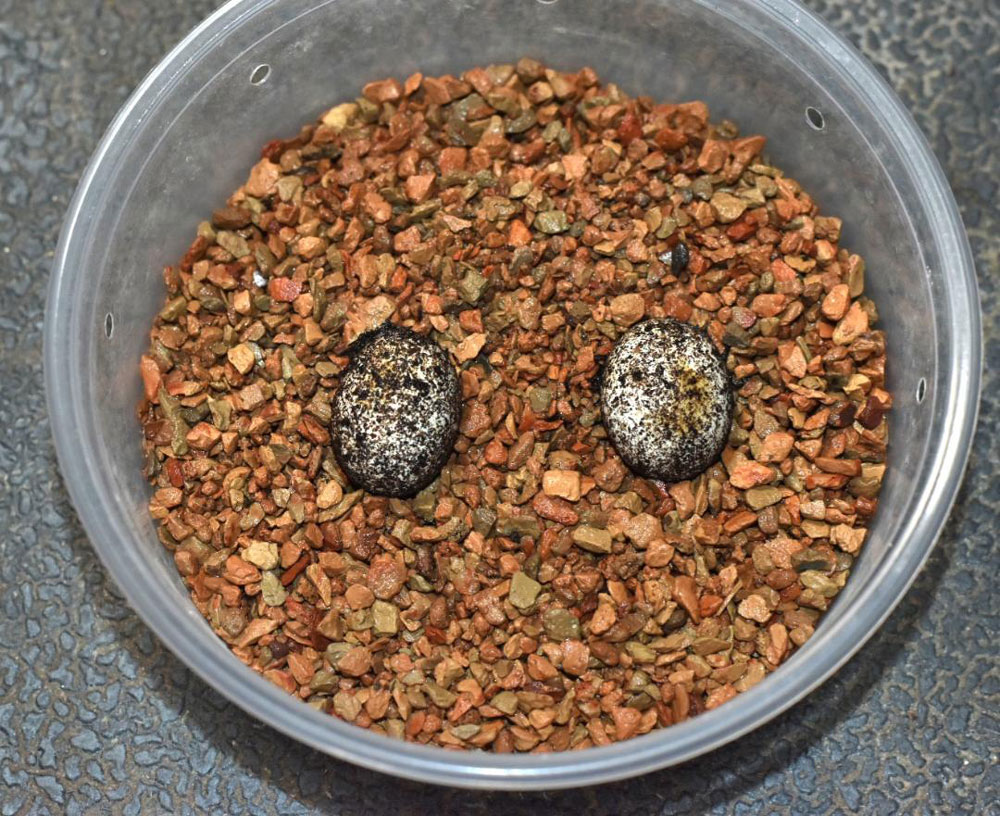
Photo by Monique Karl
For incubation we utilize 8 oz deli cups filled with reptile incubation media, which changes color based on its moisture level, allowing for easy monitoring and adjustment of water levels as needed. Each set of eggs is assigned its own deli cup to track lineage. The eggs are kept in a dark environment at room temperature (73 to 75 degrees Fahrenheit/ 22.8 to 23.9 degrees Celsius), with incubation periods ranging from 90 to 120 days. This method has consistently yielded successful hatching results for us.
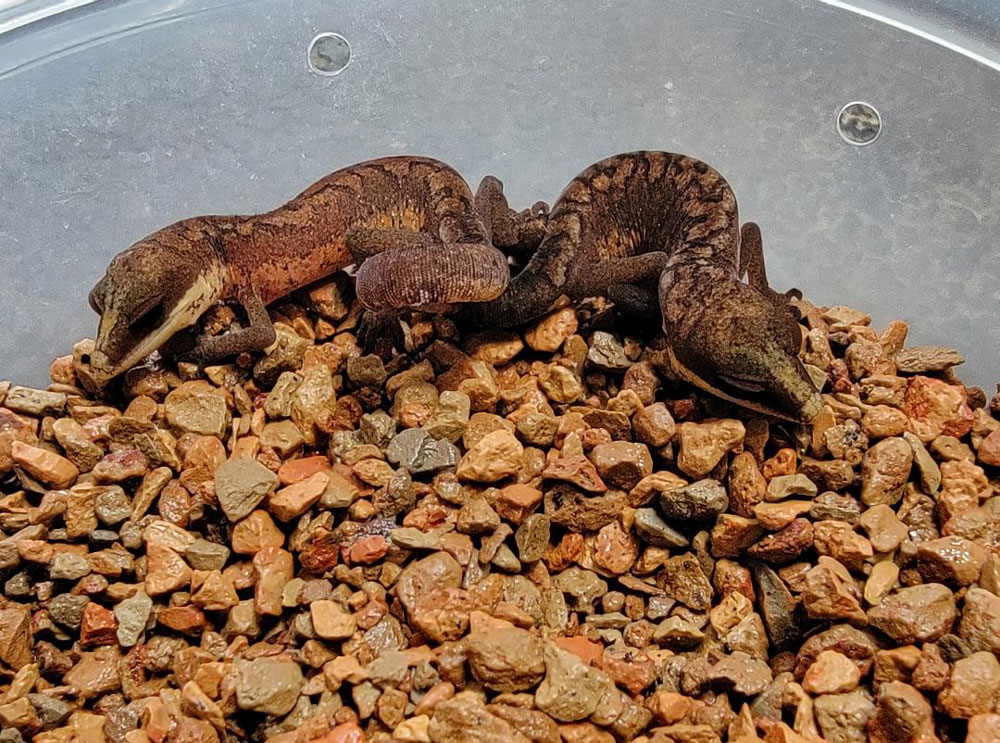
Malaysian cat gecko hatchlings. Photo by Monique Karl
Hatchling Care
Ensuring the health and well-being of hatchlings involves attention to detail and proper husbandry practices. In our experience, we utilize a 6-quart Sterilite tub with vented sides for air flow. One gecko is kept per container to keep track of health and lineage. We use a mixture of coco fiber, peat moss and soil, supplemented with a hide, sticks, a water dish and a fake plant to create a suitable habitat. We add in small isopods and spring tails to make it semi-bioactive. The tubs are also good for keeping in humidity. Temperature requirements remain the same as adults. Hatchlings are fed small crickets. We offer small crickets every three days. Once they reach 4 to 5 months old we transition them into a 12” x 12” x 18” enclosure. To reduce stress, the handling of hatchlings is limited.
Conclusion
In our opinion, the Malaysian cat gecko is a fascinating species. Although not as frequently kept as other geckos, an increasing number of reptile breeders have achieved success in breeding them, leading to greater availability of captive bred animals. Although not typically recommended for beginners, with proper husbandry they can make great reptile pets. This captivating species shows promising potential for the future.
Matt and Monique Karl are the owners and operators of Evolver Reptiles. For the past decade they have been focusing on breeding rare species of geckos, skinks, snakes and other lizards. They can be reached at www.evolverreptiles.com.

